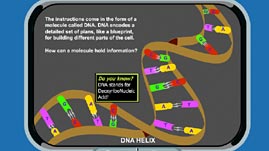Teachers' Domain - Digital Media for the Classroom and Professional Development
User: Preview

Source: Genetic Science Learning Center at the University of Utah. Note: This media asset is not served or maintained by Teachers' Domain.
In this interactive activity from the University of Utah, explore DNA and the role it plays in determining how our bodies function and what traits we have. In all organisms, the instructions for creating cell structures and for driving vital processes such as cell division are encoded in the chemical language of DNA. Take a tour of the basics of genetics and learn about DNA, genes, chromosomes, proteins, and inheritance.
Chromosomes inside the nucleus of nearly every cell are built from long strands of DNA. The ladder-shaped DNA molecule, also called deoxyribonucleic acid, is formed from many smaller molecules called nucleotides. These nucleotides, of which there are four types (usually referred to by the first letter of their chemical name, A, T, C, and G) are repeated in various sequences over and over again—three billion times in a human cell.
Genes are specific sequences of nucleotides that provide the code to build particular proteins. An organism's genes and the proteins created from them strongly influence the traits that the organism will ultimately possess. In humans, physical and behavioral characteristics result from the interplay among tens of thousands of proteins and a wide variety of environmental conditions.
Traits that result from a single gene are called Mendelian traits, after Gregor Mendel, the nineteenth-century amateur scientist who first explained genetic inheritance. Mendel studied a variety of traits in pea plants. For example, the pea plants in his study contained genes that produced either yellow or green peas. Alternate forms of another gene in Mendel's pea plants gave rise to either smooth seeds or wrinkled seeds. Studying the inheritance patterns of such simple traits made it possible for Mendel to develop the basic understanding of heredity that would ultimately give rise to modern biology and genetics.
Although most organisms, including humans, possess some traits that are determined by a single gene, we now know that the development of most traits is far more complex than the simple inheritance patterns Mendel described. In humans and in countless other animals, traits such as stature, hair and skin color, temperament, the predisposition to many diseases, and numerous other characteristics are each influenced by multiple genes and a variety of environmental factors. This complexity explains why there is such variety in the living world—a range of sizes, shapes, and colors, rather than a dichotomy of tall and short, black and white, or round and thin.
 Loading Standards
Loading Standards Teachers' Domain is proud to be a Pathways portal to the National Science Digital Library.
Teachers' Domain is proud to be a Pathways portal to the National Science Digital Library.
